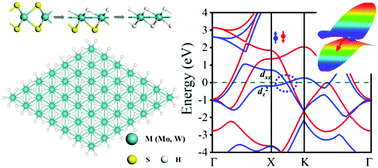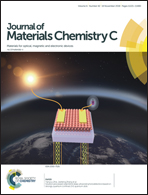Two-dimensional transitional metal dihydride crystals with anisotropic and spin-polarized Fermi Dirac cones†
Abstract
The development of two-dimensional (2D) transitional metal based crystals with nontrivial electronic and magnetic properties is important both for fundamental research and practical applications in nanotechnology. Here, we report two 2D transitional metal dihydride (MH2, M = Mo, W) crystals on the basis of first-principles calculations and the concept of hydrogen substitution of sulphur in MoS2 and WS2. In 2D MH2 crystals, metal atoms are coordinated with hydrogen atoms in either trigonal prismatic (H-MH2) or octahedral (T-MH2) configurations, where T-MH2 is more energetically stable than H-MH2. All 2D MH2 crystals are metallic, and in particular, T-MH2 is ferromagnetic with an anisotropic spin-polarized Fermi Dirac cone and high Curie temperature of about 658 K. The calculated Fermi velocities vary from 0.21 × 105 to 6.02 × 105 m s−1. Our results further demonstrate that hydrogen substitution of sulphur in MoS2 and WS2 is thermodynamically favorable, and their lattice dynamic stabilities are confirmed by both phonon spectrum calculations and Born–Oppenheimer molecular dynamic simulations at temperatures up to 800 K. These novel properties endow the 2D MH2 crystals with great potential in spintronics applications.

- This article is part of the themed collection: 2018 Journal of Materials Chemistry C HOT Papers


 Please wait while we load your content...
Please wait while we load your content...